Games PC PHARAOH User Manual
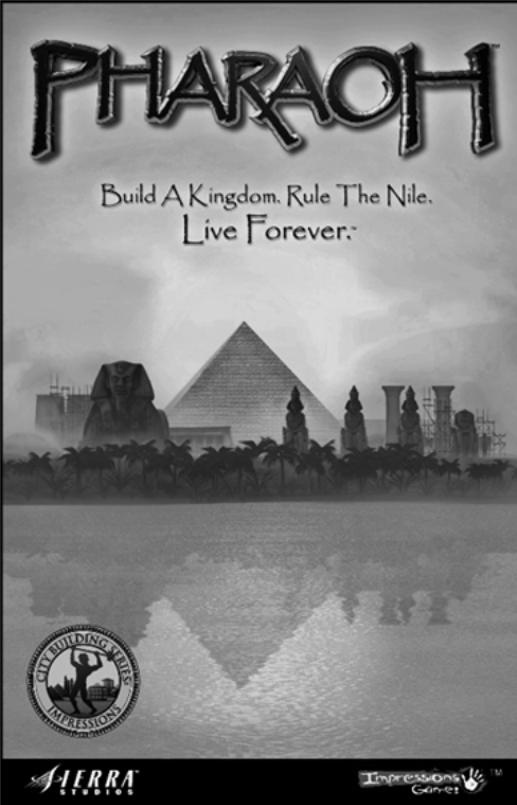

2
Credits
Designer |
Chris Beatrice |
Producers |
Greg Sheppard |
|
Ken Parker |
Director of Technology |
Mike Gingerich |
Art Director |
Darrin Horbal |
Programmers |
Jason Benham |
|
Jim Solomon |
|
Gabe Farris |
|
Chris Gurski |
|
Scott Delekta |
Lead Artist |
Heidi Mann |
Lead Animator |
Mike Malone |
Artists |
Dennis Rose |
|
Andrea Muzeroll |
|
Bob Curtis |
|
Brian Despain |
|
Kate Saparoff |
|
Ron Alpert |
|
Adam Carriuolo |
Music |
Keith Zizza |
|
Henry Beckett |
3
Sound |
Ed Saltzman |
Writer |
Lisa Gagnon |
Additional Design |
Doug Gonya |
|
Tony Leier |
Quality Assurance Manager |
Jon Payne |
Lead Tester |
Tony Leier |
Testers |
Clay Heaton |
|
Chris Bold |
|
Chris Dixon |
|
Hans Wang |
|
John McAuley |
|
Wayne McCaul |
|
Brett Levin |
Scenario Creators |
Clay Heaton |
|
Tony Leier |
|
Brett Levin |
|
John McAuley |
|
Wayne McCaul |
|
Ken Parker |
|
Jon Payne |
|
Greg Sheppard |
4 |
Table of Contents |
|
|
|
|
Table of Contents |
|
|
|
|
|
|
|
Egypt Welcomes You .................................................... |
9 |
|
|
A Quick Historical Note...................................... |
10 |
|
|
A Note on Usage................................................. |
10 |
|
|
Traveler’s Journal.................................................. |
10 |
|
|
Getting Started ............................................................. |
13 |
|
|
Installing Pharaoh on the PC ............................... |
13 |
|
|
Starting the Game on the PC............................... |
14 |
|
|
Installing the Game on the Mac .......................... |
15 |
|
|
Starting the Game on the Mac............................. |
15 |
|
|
After Pharaoh Launches ....................................... |
15 |
|
|
Your Family........................................................... |
16 |
|
|
Continuing History............................................... |
16 |
|
|
Missions and Mission Briefings............................. |
17 |
|
|
Setting a Difficulty Level....................................... |
17 |
|
|
Your Place in the World....................................... |
18 |
|
|
Losing the Game ................................................... |
19 |
|
|
Scoring ................................................................... |
19 |
|
|
Other Options...................................................... |
20 |
|
|
In-Game Help ...................................................... |
21 |
|
|
Playing Pharaoh........................................................... |
23 |
|
|
The Control Panel ................................................ |
23 |
|
|
The Menu Bar....................................................... |
28 |
|
|
Keyboard Controls............................................... |
28 |
|
|
For Players of Caesar III ....................................... |
31 |
|
|
Housing, Roads and Drinking Water ......................... |
35 |
|
|
Your City Site........................................................ |
35 |
|
|
The Kingdom Road .............................................. |
37 |
|
|
Principles Guiding Construction ......................... |
37 |
|
|
Clearing Land ........................................................ |
38 |
|
|
Building Roads ...................................................... |
38 |
|
|
|
|
Table of Contents |
5 |
||
Building Housing |
40 |
|
|
|
|
||
Housing Evolution ............................................... |
41 |
|
|
Goods and Services............................................... |
42 |
|
|
Desirability............................................................ |
42 |
|
|
Wells and Water Supplies..................................... |
43 |
|
|
People and Employment ............................................ |
47 |
|
|
Attracting Immigrants......................................... |
47 |
|
|
City Sentiment...................................................... |
47 |
|
|
Finding Workers................................................... |
49 |
|
|
People of the City................................................ |
50 |
|
|
Unemployment .................................................... |
53 |
|
|
Labor Shortages .................................................... |
54 |
|
|
Managing Labor ................................................... |
55 |
|
|
Scribes ................................................................... |
57 |
|
|
Farming and Food Production ................................... |
59 |
|
|
The Nile, the Inundation and the Nilometer..... |
59 |
|
|
Building Food and Farming Structures............... |
60 |
|
|
Flood Plain Farming and Work Camps.............. |
60 |
|
|
Meadow Farming.................................................. |
62 |
|
|
Irrigation and Water Lifts.................................... |
63 |
|
|
Crop Types ............................................................ |
65 |
|
|
Other Food Sources.............................................. |
65 |
|
|
Industry........................................................................ |
69 |
|
|
Types of Industries................................................ |
69 |
|
|
Storage................................................................... |
77 |
|
|
Running Efficient Industries ................................ |
78 |
|
|
Commerce and Trade .................................................. |
81 |
|
|
Granaries................................................................ |
81 |
|
|
Storage Yards ........................................................ |
84 |
|
|
Bazaars ................................................................... |
86 |
|
|
Planning an Efficient Distribution System.......... |
88 |
|
|
Trade ...................................................................... |
91 |
|
|
|
|
|
|

6 |
Table of Contents |
|
|
Municipal Functions.................................................... |
97 |
|
Constables and Magistrates.................................. |
97 |
|
City Sentiment and Crime ................................... |
99 |
|
Other Security Issues.......................................... |
100 |
|
Structural Flaws.................................................. |
100 |
|
Fire Prevention.................................................... |
101 |
|
Palaces.................................................................. |
101 |
|
Taxes and Money ............................................... |
102 |
|
Mansions............................................................. |
107 |
|
Your Salary.......................................................... |
108 |
|
Roadblocks.......................................................... |
109 |
|
Water Crossings .................................................. |
110 |
|
Beautification ...................................................... |
113 |
|
Religion and the Gods................................................ |
117 |
|
The Gods of Egypt............................................... |
117 |
|
Patron Gods and Local Deities ........................... |
118 |
|
Religious Buildings .............................................. |
119 |
|
Temple Complexes, Altars and Oracles ............. |
120 |
|
Festivals and Festival Squares ............................. |
124 |
|
Monuments................................................................ |
129 |
|
Building Monuments.......................................... |
129 |
|
Construction Guilds ........................................... |
130 |
|
Work Camps ....................................................... |
130 |
|
Construction Foreman and |
|
|
Overseer of Monuments ............................. |
131 |
|
Monuments......................................................... |
132 |
|
Burial Provisions.................................................. |
146 |
|
Monument Building Tips ................................... |
146 |
|
Health ......................................................................... |
151 |
|
Health Buildings .................................................. |
151 |
|
City Health and Health Risks ............................. |
152 |
|
Infected Housing ................................................ |
155 |
Table of Contents |
7 |
||
Entertainment |
159 |
|
|
|
|
||
Building Entertainment Structures .................... |
159 |
|
|
Entertainment Venues........................................ |
159 |
|
|
Measuring Entertainment Access ...................... |
162 |
|
|
Education.................................................................... |
165 |
|
|
The Military, Combat and Defense ........................... |
169 |
|
|
Raising an Army.................................................. |
169 |
|
|
Weapons, Chariots and their Manufacture ....... |
177 |
|
|
Commissioning a Navy ...................................... |
177 |
|
|
Defensive Structures............................................ |
184 |
|
|
Enemies................................................................ |
185 |
|
|
Kingdom Service ................................................. |
187 |
|
|
Overseer of the Military ..................................... |
187 |
|
|
World Map .......................................................... |
188 |
|
|
Ratings ........................................................................ |
191 |
|
|
Managing Your City................................................... |
197 |
|
|
Your Overseers .................................................... |
197 |
|
|
Overlays.............................................................. |
203 |
|
|
View.................................................................... |
209 |
|
|
Overview Map .................................................... |
209 |
|
|
World Map ........................................................ |
210 |
|
|
Citizens .............................................................. |
210 |
|
|
Messages .............................................................. |
211 |
|
|
A New Egypt Thrives ................................................ |
213 |
|
|
Designer’s Notes ....................................................... |
215 |
|
|
Appendices ................................................................ |
220 |
|
|
Appendix 1: Building Summary........................ |
222 |
|
|
Appendix 2: A Brief History of Egypt............... |
235 |
|
|
|
|
|
|
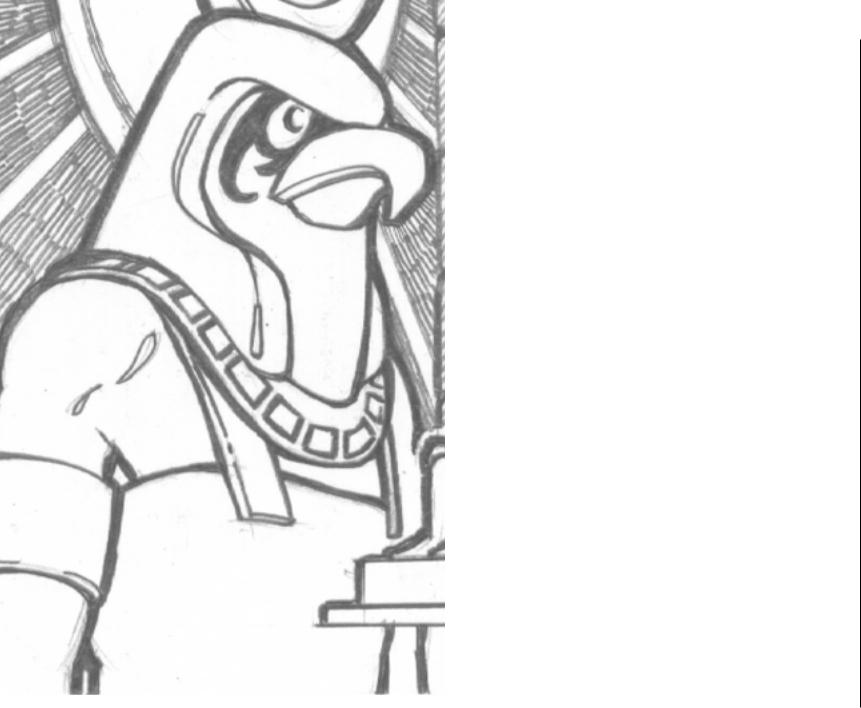
Egypt Welcomes You
Standing on the hot, arid sand, you look towards the little settlement that you call home. In the background, the mighty Nile flows by, and along its muddy banks all manner of vegetation grows, even
some small farms that some in your city have planted. Your family has lived and died along the river for generations, eking out an existence from what the land has to offer.
Yet, change is in the hot, arid air. A charismatic leader has arisen. His dream is first to unite all the settlements in the region, and then unite all of Egypt. As you ponder this dream, you have a vision: a thriving city stretches out before you. Abundant farms feed a hungry citizenry. Thousands tend to their daily tasks — protecting the city, ensuring its wealth, educating its youth, worshiping its gods, tending to its dead. The voices of your people float in the breeze and reverberate through the streets.
Inspired by your vision, you commit yourself to helping achieve the dream of a united Egypt. You instill in your children the magic of the vision, for you know it may take generations to achieve.
To realize your vision, you must learn the intricacies of the Nile. The Nile is the source of life in Egypt, and its floods bring renewal to the land every year. Learn to manage these floods, and you will make the most of this indispensable resource.
Some basic skills will help you achieve your dream. Some of them may be learned through reading the following pages; others you will have to discover for yourself.

10 |
Egypt Welcomes You |
May the gods smile upon you as you proceed along your way!
A Quick Historical Note
The action in Pharaoh takes place roughly between 3,200 BC and 1,300 BC. While Pharaoh is not a strictly historical game, events in ancient Egyptian history do shape its structure. Refer to Appendix 2: A Brief History of Egypt, starting on page 235, to learn a little about the history of ancient Egypt and to understand the context for some of the events in the game.
A Note on Usage
Throughout this text, you’ll see the word “info-click” used. Info-click means different things to different people. For PC users, info-click means right-click (click your right mouse button). For Mac users, infoclick means command-click (click your mouse button while holding down the command key). If you are a Mac user with a two-button mouse, info-click still means command-click, unless you map the right mouse button to the command key.
Traveler’s Journal
As we were researching ancient Egypt, we found a rare papyrus containing a journal written by an ancient merchant who traveled to Egypt. The journal is excerpted throughout this manual in gray boxes, like the one on the facing page.
Egypt Welcomes You |
11 |
Arriving in Egypt
Ahket, 12th year of Ramesses Morning
Dear Journal,
My first trip to Egypt —
and as we sailed up the Nile I knew one thing for certain: I wasn't in Syria anymore. The Nile itself is unlike any river I've ever seen. The first thing I noticed was the refreshingly cool breeze blowing from the north, cutting through the heat of the day. The captain of the boat, who had been to Egypt before on trade missions, told me that the locals call this breeze the Breath of Ra.
The captain certainly knew how to steer the ship. He successfully guided us through the moving maze that is the Nile. Trade ships, much like our own, clog the waterway bringing their bounty from exotic locales. Fishing boats hauling in the day's catch made their way to the docks, and small rafts piloted by local citizens darted between the larger vessels. Peals of laughter poured out from a luxury yacht, where some of the city's wealthiest residents were enjoying a pleasant cruise. Ferries conveyed people, animals and goods from one side of the river to the other. Crocodiles and hippopotamuses
patrolled the river, looking for a meal.
The captain adeptly maneuvered our boat through all these obstacles until we finally reached our destination: Waset.
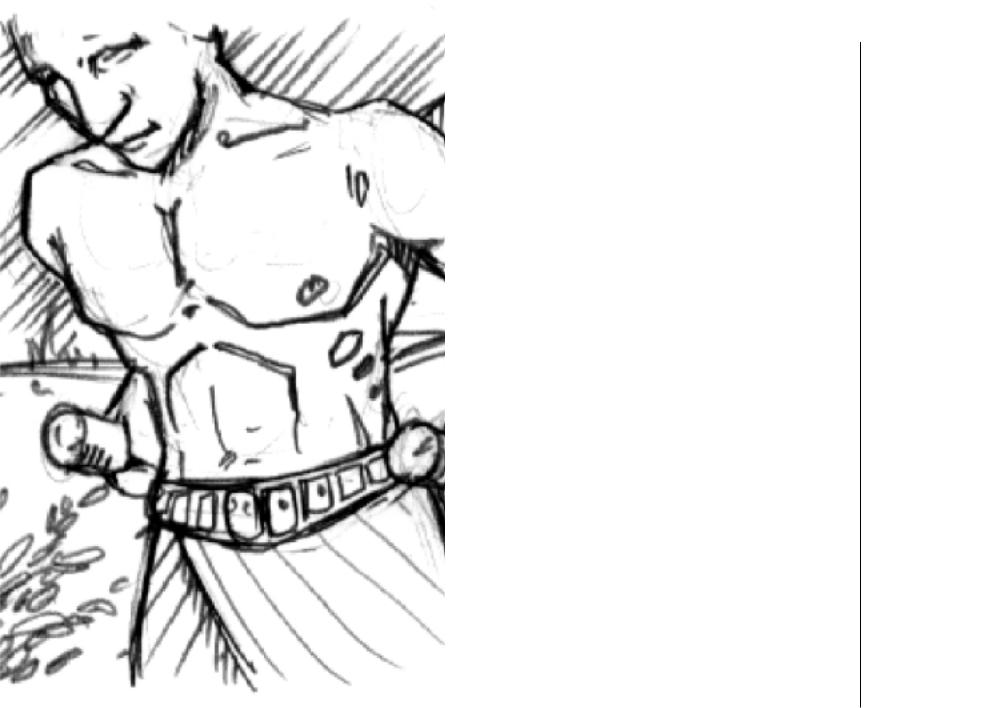
Getting Started
Installing Pharaoh on the PC
With Windows running on your computer, place the Pharaoh CD into your CD-ROM drive. In a few seconds, Windows’ AutoPlay feature should display a screen with four buttons: Play, Install, Uninstall and Quit. Click “Install” to begin.
Should AutoPlay not work on your computer, double click (click twice quickly) on the “My Computer” icon on your desktop. Find the icon for your CD-ROM drive and double-click on it. In the menu that appears, find the item called “Setup.exe.” Double click on it to start the installation.
The Install program then automatically chooses a file path for Pharaoh. If you want to designate your own path for Pharaoh, click “Browse” and pick a location. Otherwise, click “Next” to continue the installation.
You’ll be asked to choose among Small, Medium and Large Installs. Each version offers the full features of the game; the difference will be the speed of the game. The Full Install puts the entire game on your hard drive. It takes up the most room, but offers the best performance. Laptop users will especially appreciate the ability to remove the CD after the initial copy-pro- tection check. The Medium Install puts the most commonly used elements on your hard drive and takes up less room than the Large Install. The Small Install puts only basic elements on your hard drive and runs the rest of the game’s features from the CD. It takes up the least room on your hard drive.
Installing Pharaoh can take as long as ten minutes.
Once the program is installed, you will see a box
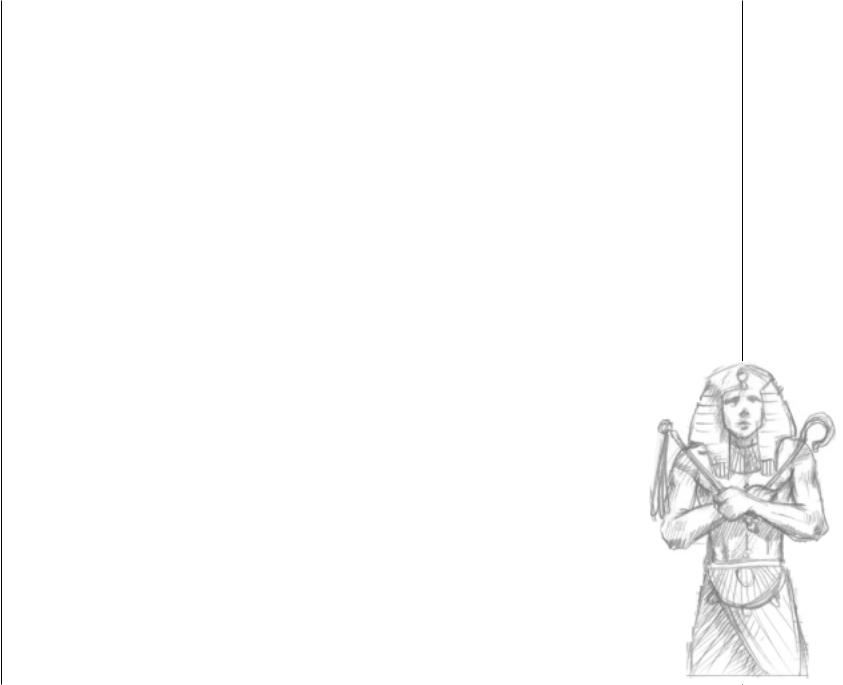
14 Getting Started
detailing the additions Pharaoh made to your start menu. Pharaoh also offers you the option of adding bookmarks to your internet browser.
At this point, you have the option of reading the “Readme” file. We know you can’t wait to see what Egypt holds for you, but we do highly recommend reading this file before you start to play the game. This manual went to print several weeks before the game was finished, and any last minute changes are described in Readme. Anytime this manual is in conflict with Readme, Readme is correct.
Now, click the “Finish” button. If necessary, Install will update some system components. It then might restart your computer.
Starting the Game on the PC
Now that the game is installed, you can start the game in one of two ways:
1.Insert the Pharaoh CD into your CD-ROM drive. When the AutoPlay window opens, click the “Play” button.
2.From your start menu, find the Sierra subdirectory and choose Pharaoh.
PLEASE NOTE: You must have the Pharaoh CD in your CD-ROM drive to start the game. If you chose the Full Install, you may remove the CD after the game begins.
Getting Started |
15 |
Installing the Game on the Mac
First, place the Pharaoh CD into your CD-ROM drive. Double-click on the icon that appears on your desktop. In the window that pops up, double click on the “Pharaoh Installer” icon. Choose the Small, Medium or Full installation (click on each to see how much disk space it requires). Click on your choice and, holding down your mouse button, “drag” the icon to a location displayed in the right-hand panel.
The Small install runs most of the game’s sounds and videos from the game CD. Choose this if you have limited space on your hard drive. The Medium install places the most commonly used media files on your hard disk. The Full install puts the entire game on your hard disk for optimum performance.
Starting the Game on the Mac
When your Macintosh finishes transferring from the CD to your hard disk, double click on the folder you just created Inside, you'll find a Pharaoh icon Double-click this icon to start the game You might want to drag this icon to your computer's desktop to conveniently start the game later.
After Pharaoh Launches
Once you launch the game, a brief |
|
describing the glory of ancient Egypt plays, |
- |
lowed by credits and the Pharaoh title |
. |
Click on the title screen, and the Main |
|
appears. |
|
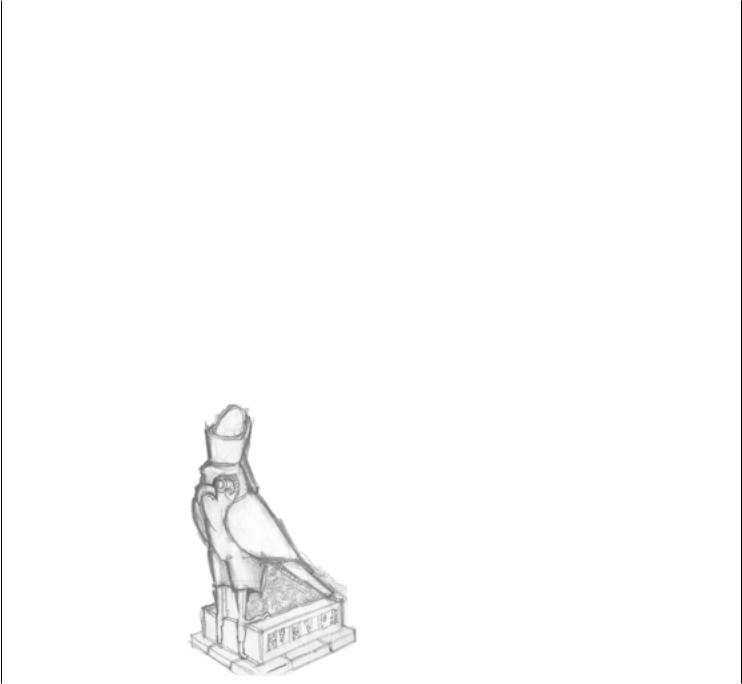
16 |
Getting Started |
From here, you can play Pharaoh, see which families are deemed to be the Greatest Families, visit the Pharaoh web site, or quit the game.
Your Family
When you choose “Play Pharaoh,” a Family Registry screen appears. The registry lists all the families that have begun to make their mark in history.
To begin a new game of Pharaoh, found a new family. From the Registry screen, click on “Create Family.” Type in a surname of your choice, or choose from the list of authentic Egyptian names.
Now, you are ready to make your way through Egypt’s history. After you have chosen a family name, click “Proceed.” From the Choose Game screen that appears, click “Begin Family History.” Then, a screen appears which lists the Periods of Egyptian history. Select the first Period, the Pre-Dynastic, then click the button in the lower right of the
screen to begin your quest.
Continuing History
If you don’t play the game all the way through the first time (who needs to sleep or eat?), you can pick up where you left off later. When
are ready to take a break, choose “Save Game” from the File Menu. The next time you start Pharaoh, choose your family’s name from
Getting Started |
17 |
Registry Screen. After you do, the Choose Game screen appears. Click “Continue History” to resume your family’s story.
If you forget to save your game before quitting to take a break, don’t fret. Pharaoh automatically saves your game twice per game year, in January and July. You might lose some of your more recent history, but not all will be lost. Choose “Load Saved Game” from the Choose Game screen and select “autosave_history” to pick up reasonably close to where you left off.
Missions and Mission Briefings
The path leading a united Egypt — and your family — to greatness is a long one with many steps along the way. In Pharaoh, these steps are called missions.
At the start of each mission, a Mission Briefing panel describes what you can expect and what you’ll need to do. When you meet the goals outlined in the Mission Briefing, you win the mission and move on to the next step.
Missions are grouped into Periods. When you finish the last mission in a Period, you automatically return to the screen that lists all the Periods in Egyptian history. You have to play the Periods chronologically (no fair skipping ahead), but you can click on any of the Periods for a brief description.
Setting a Difficulty Level
Set the level of difficulty at which you’d like to play each mission from the Mission Briefing panel. You can choose from five difficulty levels, spanning the spectrum between “Very Easy” and “Very Hard.” You can
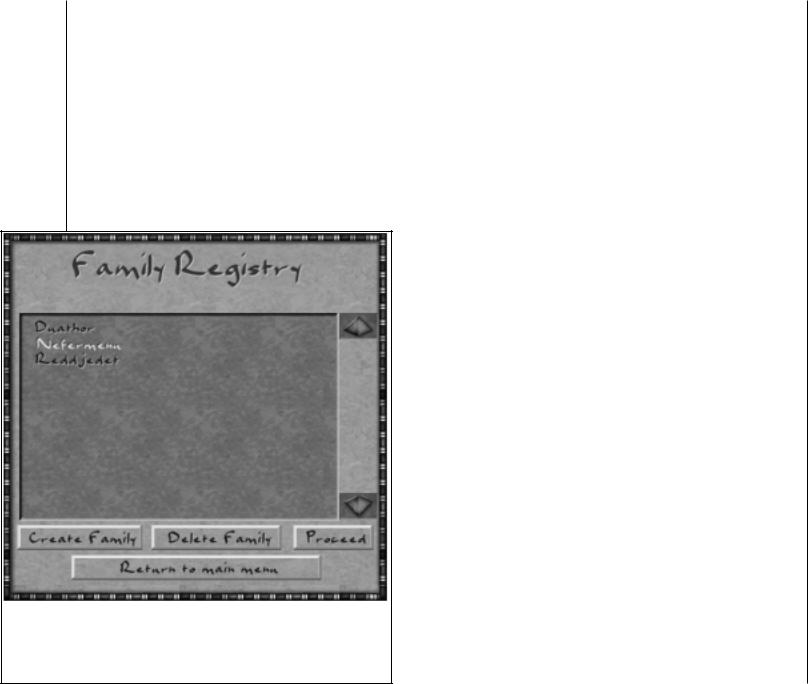
18 Getting Started
change your difficulty level at any time during a mission through the Options menu on the Menu Bar. Keep in mind, though, that lowering your difficulty decreases your score (see page 19).
Your Place in the World
It would be difficult to help build and sustain a united Egypt if you ignored other cities in the world. From time to time, other cities, and sometimes even Pharaoh, will request your aid. Generally, they ask for goods or for the services of your military. To foster
Family Registry Screen. From this screen, you can continue a previous game or start a new one by establishing a new family. If you choose, you can also delete a family. Deleting a family erases all the saved games and any history associated with it.
Getting Started |
19 |
good relations with your neighbors, you should fulfill these requests if you can. Your reputation will likely increase (see Kingdom Rating, page 194), and Egypt will be stronger for it.
Losing the Game
Even families with the noblest of intentions can meet with ignominious defeat. If you are attacked by a military force stronger than your own, you will most likely lose the game. Sometimes, your city will be attacked through no fault of your own. The invading force might just have their own vision for empire and greatness. You can, though, trigger an attack by your actions or inactions. For example, if you repeatedly ignore requests for aid, a neighboring city or Pharaoh may decide to forcibly take what you would not willingly give.
Gross mismanagement of funds, too, usually means disaster. Going into debt damages your reputation (see Kingdom Rating, page 194), and another city’s army or navy may take over your city to demonstrate the Kingdom’s disgust with you.
Scoring
At the end of each mission, you are given a score based on how quickly you completed the mission, your ratings, the size of your population, the amount of money in your coffers, the monuments you completed and your difficulty level. If you change your difficulty level during a mission, the lowest difficulty level you played is the one used to figure your score. Your score is recorded for posterity and compared to the scores of other players or to your own scores. If you

20 Getting Started
have the high score for a particular mission, your family name and final score is displayed in the Greatest Families screen, accessible from the Main Menu.
Other Options
If you need to take a break from the rigors of leading your family through history, Pharaoh offers you a couple of other ways to get a taste of Egypt. These are:
Relive History. To look back on all you have achieved, choose “Relive History” from the Choose Game screen. Here, your achievements are recorded and celebrated.
You can also replay a completed Mission or an entire completed Period by choosing “Relive History.” While you can replay history, you cannot change it. Replaying any mission has no effect on your current full history game.
Please Note: If you are replaying a particular mission, be sure to save it with a distinct and different name than your full history game. If you accidentally give the mission the same name as your full game, your history will be overwritten and lost.
If you are replaying a completed mission and forget to save it, open the “autosave” file listed when you choose “Load Saved Game” from the Choose Game screen. Pharaoh automatically saves your mission every six game months, so you’ll be able to recover a reasonably up-to-date version of your current mission.
Getting Started |
21 |
Custom Missions. Pharaoh comes with a few missions that are not part of any larger game. To play one of these missions, choose “Custom Missions” from the Choose Game screen. Custom missions are also automatically saved every six game months should you forget to do so yourself.
In-Game Help
Just about everything you need to know about Pharaoh is contained right in the game. The “Help” drop-down list in the Menu Bar provides access to detailed information regarding Pharaoh.
Mouse help describes some items. If you hold the mouse over Control Panel buttons or Menu Bar items, a small panel briefly describing the object will pop up.
Also, info-clicking on just about anything provides a wealth of information. The first screen that pops up when you info-click an object provides brief information needed to manage your city. The lower left corner of these screens has a question mark. Click on that question mark for a more detailed description of the object and to learn more about the object’s role in the game. These entries are usually linked to other useful topics and to historical information. Linked topics are displayed in a different color from the rest of the text.
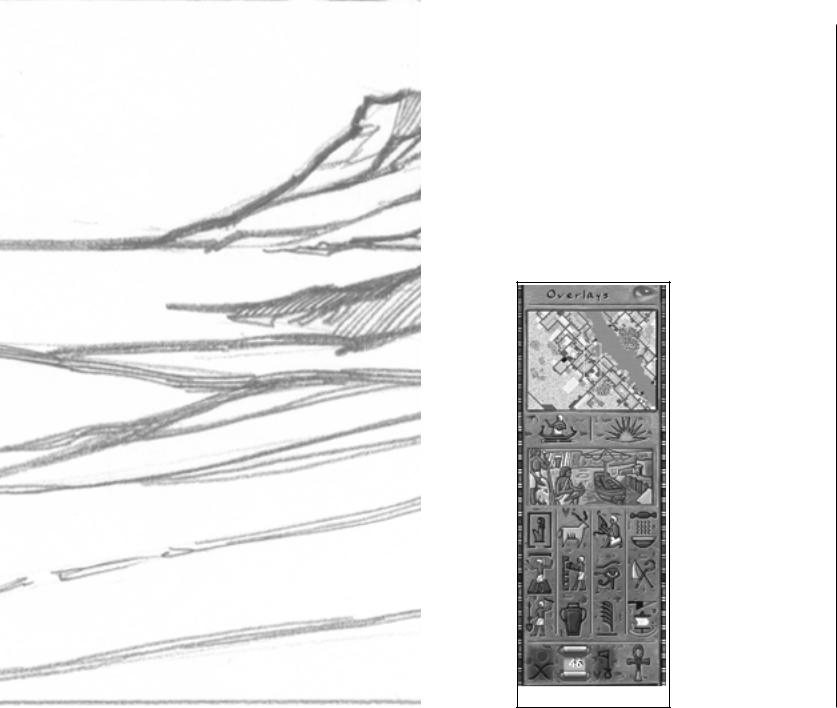
Playing Pharaoh
Empty land can be inspiring. With an expanse of land stretching out before you, anything is possible. You can envision the perfect city with
majestic temples reaching towards the sky, busy thoroughfares crowded with people and animals, and farmland heavy with crops. Luckily, you have the unique ability to make this perfect city real. The tools described below will help you achieve your dream.
The Control Panel
The Control Panel is your command center: every order you can give in the game can be accessed here.
The Control Panel
When you first begin to play Pharaoh, not all the commands on the control panel are available to you. Early in the game, Egypt is a fledgling culture that has not developed fully. As Egyptian culture and civilization evolve, you will be able to build more elaborate cities with more buildings and services for your citizens. Options currently not available are darkened.
You should also note that Egypt’s various regions each have different natural resources and landscapes. Some regions are arid, with rich mineral resources, while
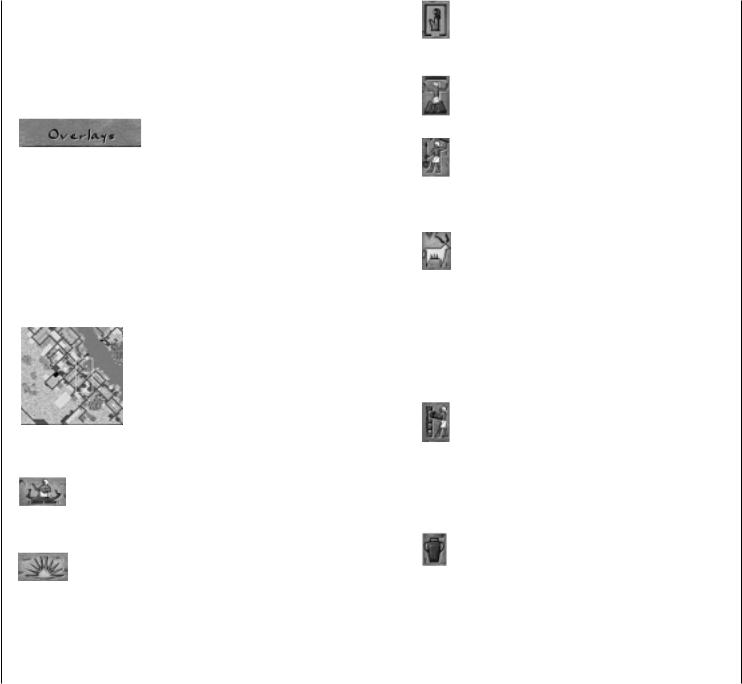
24 |
Playing P |
other regions are lush. Because of this variety and the gradual development of Egyptian culture, the buildings available to you in each mission are different.
Each button on the Control Panel is described below:
Overlay Selector. Click the overlay selector button to choose special, informative views of your city. For more on
overlays, see pages 203-209.
 Hide Control Panel. Click this button to hide the Control Panel. You’ll see more of your city, and you’ll still be able to see the building construction buttons, but you won’t see the Overview Map or the buttons to access the World Map or the Overseers.
Hide Control Panel. Click this button to hide the Control Panel. You’ll see more of your city, and you’ll still be able to see the building construction buttons, but you won’t see the Overview Map or the buttons to access the World Map or the Overseers.
Overview Map. The overview map shows more of your city at one time. Point and click on any part of the map to jump your view to that area. The buildings on the map are color-coded depending on their
function. For more on color coding, see page 209.
Overseers Button. Click this button to consult your Overseers. For more on Overseers and
their functions within the game, see pages 197-203.
World Map Button. Click this button to view a map of the entire known world. Other cities in the world are clearly marked, and you can watch
armies and navies as they make their journeys. For more on the World Map, see page 210.
Playing P |
25 |
Housing Button. Click this button to designate housing areas. For more on building housing areas, see pages 40-43.
Roads Button. Click on this button to build roads. For more on roads, see page 40.
Clear Land Button. Use this button to clear land of obstructions. A special “Dig” cursor appears after you click the button. To read more on
clearing land, turn to page 38.
Food and Farming Structures Button. Click this button to build the structures that produce food for your city. Also listed here are farms that grow
raw materials for industries. The food and farming structures are Farms, Work Camps, Hunting Lodges, Fishing Wharves, Cattle Ranches, Water Lifts and Irrigation Ditches. For more on food and farming, consult pages 59-67.
Industrial Structures Button. Click here to build any of the industry buildings in Pharaoh, including raw material producers, manufacturers and
construction guilds. For more on industry in Pharaoh, see pages 69-79. For more on construction guilds, see page 130.
Storage and Distribution Structures Button. Click on this button to build a Storage Yard, Granary, Bazaar or Dock. Each structure plays a distinct role in getting goods and food to the city’s people. Docks
and Storage Yards are also key to trade. For more on distribution of food and goods to citizens, see pages 81-91. For more on trade, go to pages 91-95.
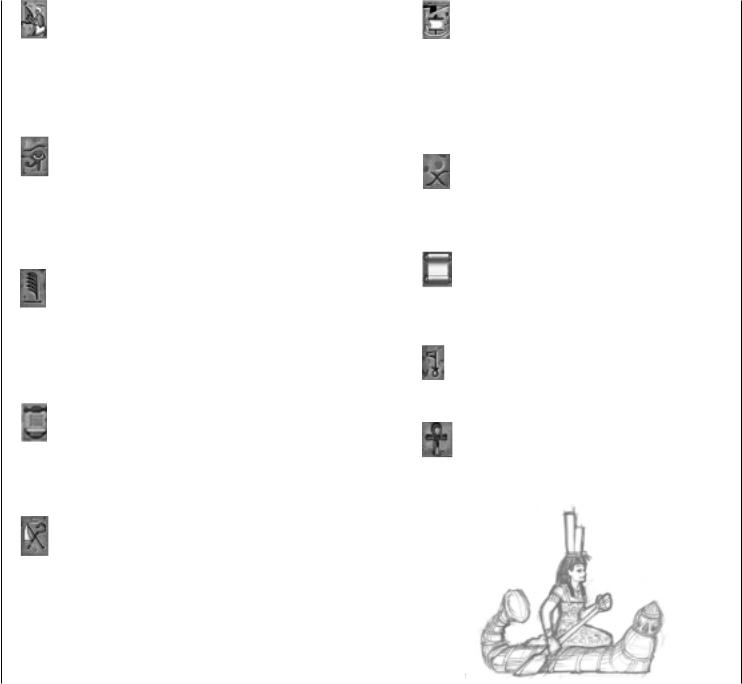
26 |
Playing P |
Entertainment Structures Button. When citizens demand entertainment, click this button to build them the attractions they desire, such as Booths, Bandstands, Pavilions and Senet Houses. Use this button to build performers’ training facilities as well. For more on entertainment in your city, turn to page 159.
Religious Structures Button. Click here to build Shrines, Temples and a Festival Square. If you are building monuments (like a Pyramid or Sphinx), they will be listed here. For more on religion, consult pages 117-127. More on monuments can be found on
pages 129-149.
Education Structures Button. When you are ready to bring the light of learning to the city’s well-to- do residents, click the “Education Structures” but-
ton and choose either Scribal School or Library. For more on the construction of these two buildings, see pages 165-166.
Health and Sanitation Structures Button. Click on this button to build Wells, Water Supplies, Physician’s offices, Mortuaries, Dentist’s offices and Apothecaries. For more on Health and Sanitation
in Pharaoh, visit pages 151-157.
Municipal Structures Button. Clicking this button reveals a long list of buildings that help to keep the city running. Included in the list are the
Police Station, Firehouse, Architect’s post, Tax Collector’s office, Courthouse, Palace, Mansion, Water Crossings, Roadblock and Beautification structures. For more on municipal functions, consult pages 97115.
Playing P |
27 |
Military Structures Button. Click here to begin establishing an army and a navy or to build defensive structures. Buildings listed here include
Recruiter, Forts, Academy, Warship Wharf, Transport Wharf, Weaponsmith, Chariot Maker, Wall, Tower and Gatehouse. For more on the military, turn to pages 169-189.
Undo Button. When this button is lit, you can undo your last action. You can undo most actions, but you have only a limited time in which to
do so.
Messages Button. Click here to read your messages, including any special instructional messages, which are each marked by a blue scroll.
Messages are discussed on page 211.
Trouble Spots Button. Click here to visit the sites of recent or on-going trouble, such as a fire or building collapse.
Review Assignment Button. Click this button if you need to refresh your memory regarding your goals for the current mission. See page 17 for
more on your mission assignments.

28 Playing Pharaoh
The Menu Bar
The Menu Bar which runs across the top of the screen helps you manage your game play. Under the File Menu, you’ll find basic options like loading and saving games. Under Options, you can customize the appearance of the game. The Help Menu is also in the Menu Bar. Should you want to consult a specific Overseer, the Overseers Menu lists each one, and you can choose which you’d like to visit.
Next to the Overseers Menu is the amount of money the city has and its current population size. Next to the population figure is a pyramid. Use this pyramid to reorient your view of the city. Clicking on the right side of the pyramid rotates the city counter-clockwise. Clicking on the left side of the pyramid rotates the city clockwise. Click on the center of the pyramid to reorient your view due north. Rotating your view can be helpful, especially if large buildings obscure your view of structures behind it. The last item on the Menu Bar is the current date.
Keyboard Controls
Pharaoh offers many optional control shortcuts that you can access with a simple keystroke. Please refer to the "Readme" file in your computer's Pharaoh folder for any changes or updates to this list.
Key Effect
AOrders a selected warship to attack all enemies.
CShows the Risks: Crime Overlay, or orders a selected charioteer company to charge.
Playing Pharaoh |
29 |
DShows the Risks: Damage Overlay.
EOrders a selected transport ship to evade enemies.
FShows the Risks: Fire Overlay, or orders a selected company to return to its Fort.
HOrders a selected ship to hold its current position.
LCenters your view on a different military company each time it's pressed.
If a company is selected, "L" issues the "hold ground in loose formation" order.
MWhen you select a monument from the building list, its image attaches to your cursor and shows you how much land the monument will occupy. Pressing the "M" key freezes the monument's "footprint" into place so that you can move your viewpoint around the city without moving the monument's tentative location. Press the "M" key again to resume normal mouse behavior, or click to place the monument in the footprint’s current location.
Pressing "M" when a military company is selected issues the mop-up order.
NOrders a selected company or warship to attack nearby enemies.

30 Playing Pharaoh
PPauses the flow of time in the game. You cannot build while time is paused.
RWhen placing a Statue, Gatehouse or Temple Complex, "R" rotates the structure's orientation one-quarter turn clockwise. Statues will display multiple styles.
|
With a military company selected, "R" orders |
|
the soldiers to change their orientation |
|
(rotate). "R" also orders a selected transport |
|
or warship to return to the Shipwright for |
|
repairs. |
T |
Shows the Risks: Problems Overlay. |
|
With a military company selected, "T" issues |
|
the "hold ground in tight formation" order. |
W |
Shows the Water Overlay. |
|
If a warship or transport ship is selected, “W” |
|
orders the ship to return to its home Wharf. |
Space |
Press the spacebar to toggle between your last |
|
selected Overlay and the normal city view. |
Esc |
(escape) exits the game. |
[ |
(open bracket) reduces game speed by 10 per- |
|
cent. |
] |
(close bracket) increases game speed by 10 |
|
percent. |
`(accent) Overseer of the Workers
Playing Pharaoh |
31 |
1Overseer of the Military
2Political Overseer
3Ratings Overseer
4Overseer of Commerce
5Overseer of the Granaries
6Overseer of Public Health
7Overseer of Learning
8Overseer of Diversions
9Overseer of the Temples
0Overseer of the Treasury
- (minus sign) Chief Overseer
= (equals sign) Overseer of Monuments F7 Set 640x480 screen resolution
F8 Set 800x600 screen resolution
F9 Set 1024x768 screen resolution
For Players of Caesar III
Egypt and Rome are very different places. Some of the skills you learned as a successful Roman Governor may not help you as an Egyptian leader. If you are a fan of

32 Playing Pharaoh
Caesar III, take note of of the following:
Religion. Most cities in Egypt have a patron god that requires more attention than other deities in the city. In some cities, certain gods are completely unknown.
Floodplain Farms and Work Camps. Work Camps provide peasant labor (in the form of walkers) to floodplain farms. Floodplain farms do not directly employ their workers.
Gold. Gold can be mined from certain rock and converted into currency, measured in debens.
Tax Collection. Before you can collect taxes, a Palace must be functioning in the city. Tax collectors from the Tax Collector’s offices will not be able to squeeze one deben from citizens unless the city has a Palace.
Luxury Goods. Foreign luxury goods, the commodities most prized by occupants of high-level housing, are very expensive to import. Due to the expense of safely transporting them across difficult terrain, it is not lucrative for a city to export luxury goods.
Now that you’re familiar with the basic city-building tools, you’re ready to begin building the most magnificent city Egypt has ever known.
Playing Pharaoh |
33 |
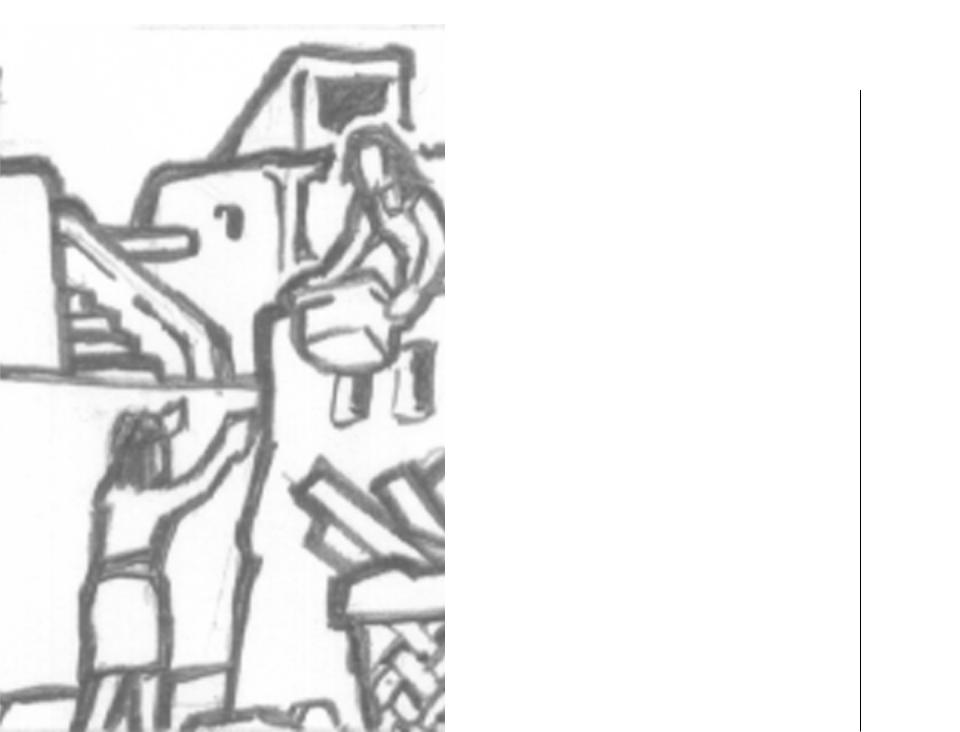
Housing, Roads and
Drinking Water
T he first step to attracting people to your city is to designate areas for housing. When the first immigrants come to your city, they are content to live in rudimentary structures. As your city
develops and its people become more sophisticated, they expect to build their homes into more impressive domiciles.
Your city needs roads if citizens are to move about. Only a few people, for example soldiers and immigrants, can leave the road. When you first arrive at your city site, you will notice a main road cutting through your land. Build more roads off this main road, line them with housing areas, and soon you will have neighborhoods teeming with activity.
Citizens also need your help in meeting their most basic need: water. Without drinking water, your citizens cannot survive for long.
These structures — housing, roads and water structures — are the most basic needs in any city. Mastering the art of constructing these structures gives you the fundamental knowledge you need to build a great city.
Your City Site
Before you begin building your city, take a look at the land on which you will establish it. Your city’s site and the surrounding area have many different terrain types, each of which is suited for a different purpose.
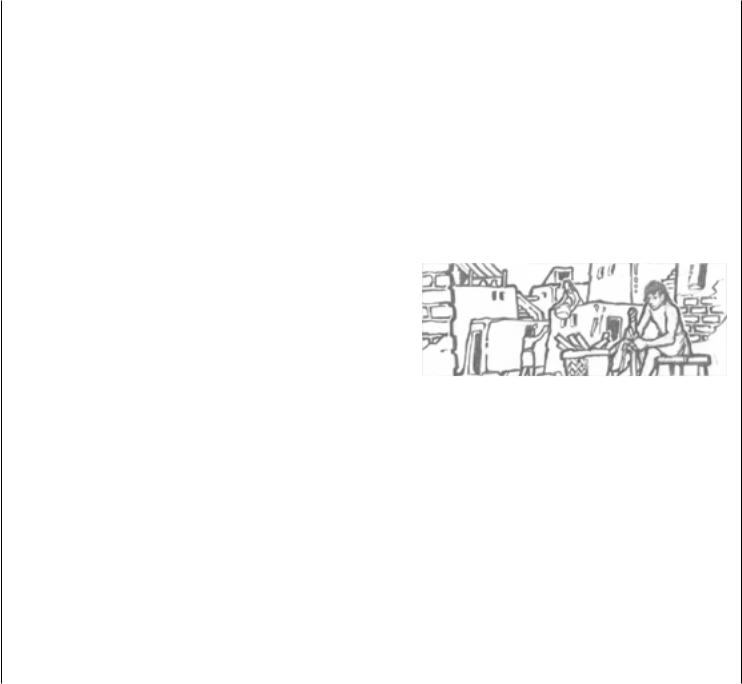
36 |
Housing, Roads and Drinking Water |
Grassland. Grass grows on land near water, indicating that there is groundwater flowing underneath it. Because of this groundwater, you can place water-related structures on grassland.
Meadow. Meadows, identified by their yellow vegetation, can support farms (see page 62).
Flood plain. The flood plain is generally the most fertile land in Egypt. Found along the banks of the Nile, the land’s fertility is restored each year when the Nile floods its banks (see page 59). Because of the annual flooding, farms, roads and Irrigation Ditches are the only structures that can be built on the flood plain.
Desert. Deserts are often a good place to build industries (see pages 68-79), but a poor place for housing because it is difficult to supply these areas with clean drinking water. Deserts cannot support water-related structures.
Sand Dunes. Sand dunes form when the desert wind blows. Nothing can be built on sand dunes, but people can walk over them.
Forest. If there is a forest in the area, you may be able to harvest wood (see page 72). You can also permanently cut down a forest by clearing the land (see page 38).
Marshland. Marshes are the habitat for reeds (see page 72), which can be made into papyrus. Marshland is found near water and sprouts very dark green reeds. Because the ground is so wet, you cannot build anything directly on the marsh,
Housing, Roads and Drinking Water |
37 |
nor can you clear marshland.
Rock. Rocky outcroppings sometimes indicate the presence of construction-grade stone, valuable ores or precious gemstones (see pages 69-71). Rock is impassable; people cannot walk over rock and must walk around it. You cannot build anything directly on rock.
Water. The Nile carves a swath through many regions, and other areas may have oases or small ponds. Naturally, you cannot build any structures directly on the water.
The Kingdom Road
The Kingdom Road cuts through the city and links it to other cities in Egypt and the world. Immigrants also use the Kingdom road to get to your city. Be careful not to isolate your city from the Kingdom. Your city must have access to the rest of the Kingdom to survive.
Principles Guiding Construction
The same basic principles guide building most structures in the game. The rather large exceptions to the rule are monuments, which are discussed fully on pages 129-149. To build the rest of the buildings, the basic steps are:
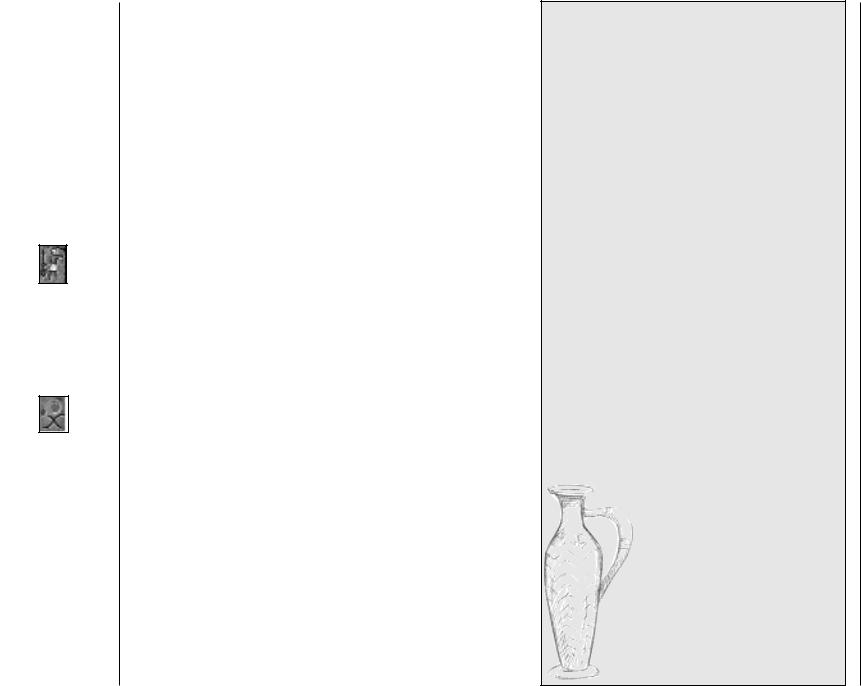
38 |
Housing, Roads and Drinking Water |
Clear Land Button
Undo Button
1.Clear the land, if necessary.
2.Choose the appropriate button from the Control Panel.
3.Place your building.
You will know if you are choosing an appropriate place for your building if you see a green “ghost” of it as you move the cursor over the desired location. If you see red, the land is not clear or the building you’ve chosen has special requirements which you have not yet met.
Clearing Land
With the exception of monuments, you must clear the land first before building a structure. To clear land, click on the “Clear Land” button on the Control Panel. When the special Dig cursor appears, click on the spot that you would like to clear. You can clear large areas at one time by dragging your cursor over the land. The land clears as you drag the mouse, and the amount of money needed to clear it is displayed. You can reshape the area of land you’re clearing by repositioning the cursor, but once you let go of the mouse button, the land is cleared and the money is spent. If you change your mind, click the “Undo” button on the Control Panel. Do so quickly, however, because you have a limited amount of time in which to undo any action.
If a forest is blocking your way, think carefully before clearing it. Wood is an extremely rare and valuable commodity, and it may behoove you to change your city design instead of clearing the forest.
Building Roads
Most structures in Pharaoh need road access. If citizens
Housing, Roads and Drinking Water |
39 |
Egypt’s Neighborhoods Ahket, 12th year of Ramesses Evening
Dear Journal
After the arduous task of unloading our ship’s cargo, I was ready for a good night's sleep. I stationed a guard outside the Storage Yard we had procured for our goods and made my way to Khmunhotep's house. I met Khmunhotep last year, when he worked as a scribe who accompanied trade missions abroad. He told me that I would be most welcome in his house if ever I found myself in Egypt.
I made my way through the twisting and turning streets to Khmunhotep's neighborhood. It was clear to me as I walked that Egypt is much like other places I've been: not everyone shares equally in the land's wealth. Some of the homes were quite run down, while others were larger and kept up. I entered Khmunhotep's street where the homes were quite large. The residents were obviously well off, and most probably worked for the government.
Khmunhotep's home is filled with fine things that point to his status. His pottery is the finest available, and the clothing his family wears is made of very sheer linen, a mark
of quality. He scents his home with imported from Pwenet. Of
course, these luxuries come with a price: he has one of the highest tax bills in the neighborhood. Tired from my journey, I
retired to bed. The typical Egyptian headrest, a curved piece wood atop a small pedestal, didn't
especially inviting, but this “pillow” proved to be surpris-
restful.
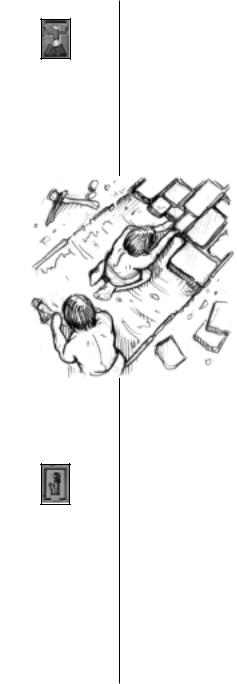
40 Housing, Roads and Drinking Water
Road Button
Build Housing Button
can’t get to a building via a road, they can’t acquire the goods or services that building provides nor can they find employment there.
To build a road, first make sure the land is clear. Then, choose the “Road” button, and click on the area where you would like to place a road. Just as with clearing the land, you can build large sections of road at one time by clicking and dragging the mouse. As you drag
the mouse, you see what the road will look like after it’s placed and how much it will cost. If there are any barriers, such as uncleared land or a building, the road bends around the obstruction. When you let go of the mouse button, the road is laid.
When neighborhoods begin to prosper, the city’s residents take it upon themselves to pave over dirt
roads. Once a road is paved, you can place Plazas on them (see pages 113-114).
Building Housing
You never build or improve housing directly. Rather, you define areas where you want people to settle, and they do the rest. When your city is new, some immigrants always show up to build homes as soon as you earmark the land for them. After this initial influx of people, your city must attract new citizens by offering the things people want — mainly food, jobs and housing.
To designate a housing area, first click on the ”Housing” button on the Control Panel. Then, click
Housing, Roads and Drinking Water |
41 |
on the area where you’d like to place some housing. You can designate housing areas one lot at a time, or you can hold down the mouse button and drag over larger areas. You can even drag an area of housing over roads — the roads remain in place. After you earmark an area for housing, a “vacant” sign appears on the land. When immigrants arrive, they will construct their own simple structures.
All housing must be placed within two spaces of the road and must be built on clear land. Make sure there is a clear path between the housing areas you designate and the Kingdom Road. You may need to build water crossings (see pages 110-113) so that immigrants can get to certain areas.
Housing Evolution
As conditions improve in the city, your citizens will want to live in more attractive structures. They will upgrade their housing on their own. The advantages of highly evolved housing are many, including increased tax revenues and improved prosperity (see page 192). All you need to do to foster the development of better housing is to make sure your citizens live in pleasant neighborhoods and have access to the goods and services they want.
Dilapidated houses drag down the desirability of the surrounding area. Ramshackle housing catches fire easily; as housing improves, the chance that it will catch on fire decreases. Fine homes also enhance the desirability of the surrounding area, perhaps even helping other nearby houses to evolve into better domiciles.
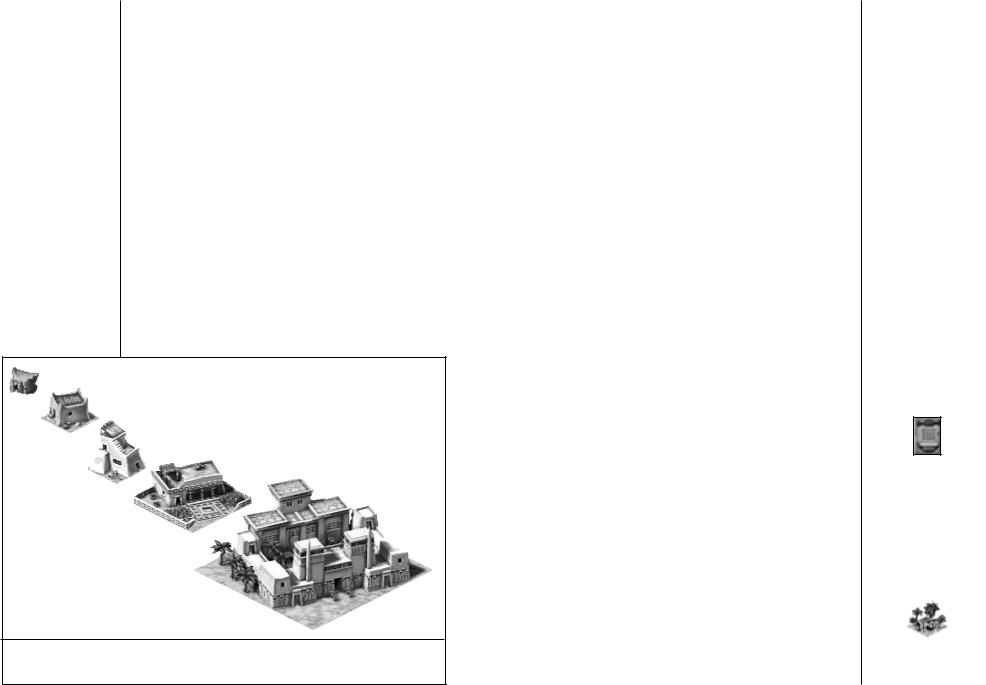
42 Housing, Roads and Drinking Water
Goods and Services
What do your citizens want? Their needs aren’t much different from our own. They like a varied diet and goods, such as pottery, linen and beer, that make their lives easier and more fun. As your citizens become wealthier, they also want luxury goods, both domestic and imported, in their homes. The chapters on food and farming (pages 59-67) and industry (pages 69-79) will tell you how to provide these items.
Access to services, such as education (pages 165-166), religion (pages 117-127) and entertainment (pages 159-163), enriches your people’s lives and encourages them to build more impressive homes.
Desirability
Citizens will improve their housing if you surround
Housing Evolution. As conditions in your city improve, your citizens will take it upon themselves to build more elaborate dwellings.
Housing, Roads and Drinking Water |
43 |
them with beauty. Neighborhoods with lush Gardens and stately Statues are most appreciated by your citizens.
Equally important to adding attractive elements is keeping unattractive elements to a minimum. Your citizens won’t relish living near noisy and smelly industrial structures or buildings that unsavory characters frequent. For more on each building’s particular effect on desirability, consult Appendix 1, starting on page 222.
The easiest way to find out what a specific dwelling needs to evolve, or what is preventing it from evolving, is to info-click on it. The pop-up screen tells you exactly what the house needs next to evolve. It also provides an inventory of household goods. This inventory shows you if the dwelling is about to run out of anything which might hinder its future development.
Wells and Water Supplies
Wells and Water Supplies provide drinking water to your populace. These structures cannot be placed just anywhere — they must be built on grassland (see page 36). Grassland indicates the presence of groundwater. A green “ghost” of the water structure will appear when you have chosen a viable location. You can also use the Water Overlay (see page 204) to see which land can support water-related structures.
A Well is the most basic water structure. It provides access to fairly clean drinking water to a limited range of homes. While some water is better than no water, a Well is less beneficial than its cousin, the Water Supply.
Health and Sanitation
Structures Button
Well
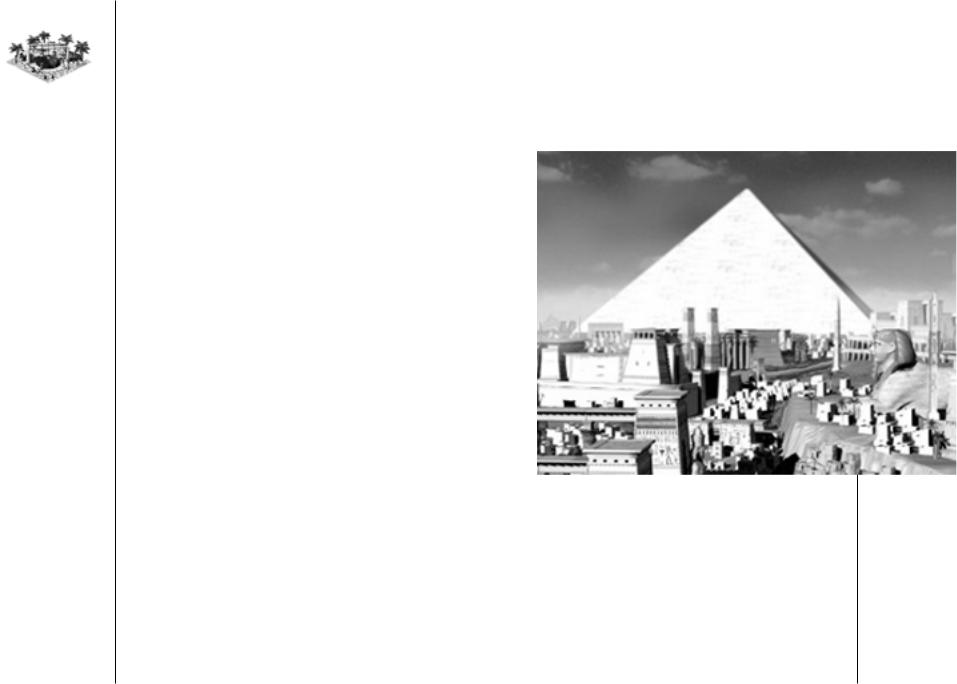
44 |
Houses, Roads and Drinking Water |
Water Supplies need road access and employees to carry the water to nearby homes. Water Supplies and their water carriers can cover a wider area of your city than Wells can, and the water they provide is much
cleaner than that provided by Wells.
Water Supply
Water Supplies also help reduce the risk of malaria striking the city (see page 154).
Houses, Roads and Drinking Water |
45 |
|
|
|
|
|
|
|
|
|
|
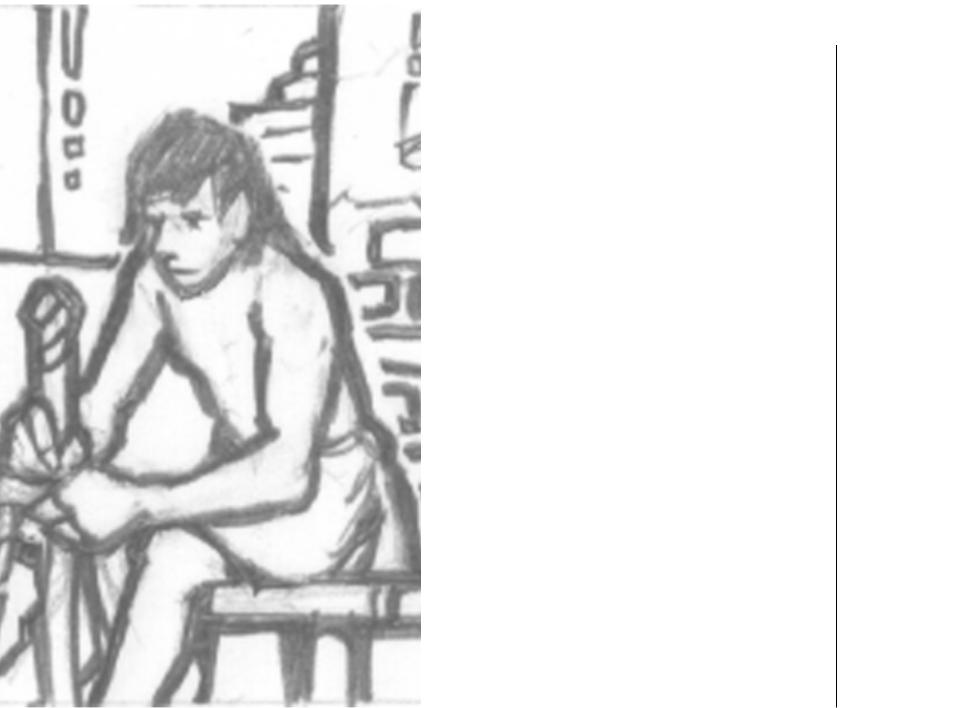
People and Employment
As the city grows, it comes alive with people going about their daily tasks. New families arrive, others depart. The workforce tends to
its responsibilities, bringing services to the citizens. Men, women and children are all active participants in city life. They are the city’s lifeblood, coursing along its streets. The citizens’ lives — how they come to your city, how they find employment, and what happens after they attain wealth — are the topics of this chapter.
Attracting Immigrants
When the city is new, immigrants in search of adventure come to experience life on a new frontier. As the city becomes more established, new immigrants are attracted mainly as a result of word-of-mouth. If life in the city is good, resulting in high City Sentiment, then the residents will spread the word throughout the Kingdom. New people will come to the city provided there is room for them.
City Sentiment
City Sentiment is an indicator of the quality of life in the city. The factors that contribute to high City Sentiment are high wages, low taxes, food availability and job availability. All citizens expect to be properly fed and to be employed. They also expect to be adequately compensated for their work and not to pay an unreasonable tax rate.
Citizens are well aware of what wages other Egyptian cities pay. If the Kingdom’s standard wage level changes, a message notifying you of the new pay rate will be sent.
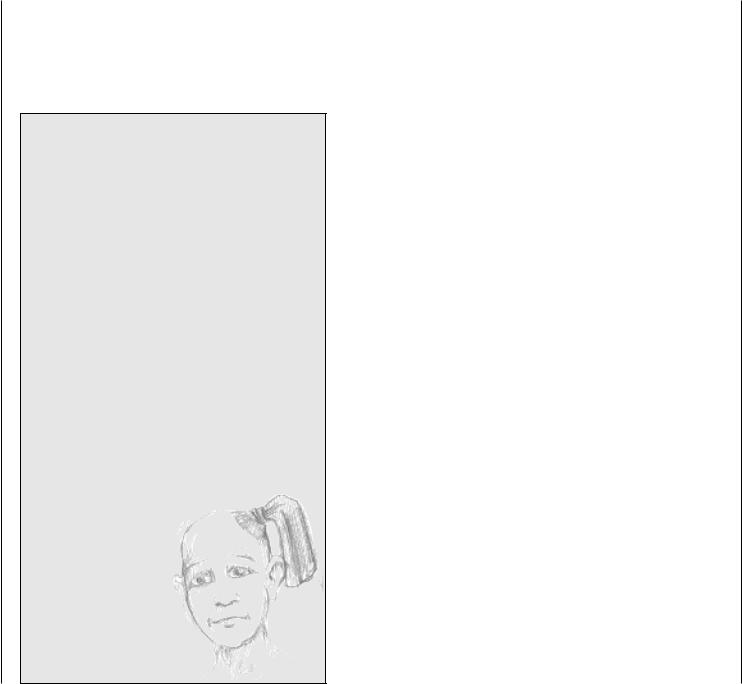
48 People and Employment
You can get away with charging citizens higher taxes if the city is otherwise a great place to live. Citizens won’t mind paying a little extra to live in a city with plenty of food, jobs and decent wages. Citizens will become upset, however, if they feel conditions are
Khmunhotep’s Family Ahket, 12th year of Ramesses Morning
Dear Journal,
Nefernetka, Khmunhotep's wife, greeted me when I finally arose in the morning. She offered me a delicious porridge of grain for breakfast. While I was eating, the children came in to see the newcomer. All the children still have the 'side lock of youth': their hair is cut short except for a long tress of hair that comes from the side of their heads. The eldest, who is nearly 14, will soon have this side lock cut off and endure the sebi ceremony in which he will be circumcised. Once he has entered adulthood, his family will send him to the Per-Ankh, which we call library, to learn his father's craft.
After the children returned to their toys, Nefernetka told me of a recent misfortune that befell her family. Her father passed on after a long and fruitful life. Nefernetka misses her father terribly, but takes comfort in the knowledge that he lives on in the Field of Reeds. Nefernetka also rests easy knowing that, in accordance with Egyptian
tradition, one-third of father's estate passes to Nefernetka's mother.
Nefernetka and her sib lings share the other two-thirds. At least the family is free from want.
After breakfast, left Khmunhotep's home negotiate a trade on of my country.
People and Employment |
49 |
unfair in the city. If half the citizens are paying high taxes, and the other half are paying no taxes at all, City Sentiment will plummet.
If you fail to meet citizens’ expectations, the word will quickly spread to others considering a move to your city. Potential immigrants will decide to stay where they are or find another city to call home if your city has a poor reputation, as expressed by the low sentiment of its residents. If your city’s reputation drops too precipitously, some of its residents may move out in search of a better life.
Your Chief Overseer (see page 203) knows how citizens are feeling. Use his City Sentiment report as a guide to improving conditions in your city.
In addition to limiting immigration, poor City
Sentiment can also encourage crime (see page 99).
Lack of housing is the other major factor that keeps immigrants away. Check in with your Overseer of the Granaries (see page 200). He can tell you how many more people the city’s current housing stock can host. If housing is almost completely occupied, zone some new housing areas to attract new immigrants, or take steps to encourage existing homes to improve. Better housing accommodates more people.
Finding Workers
Most buildings require employees (you’ll learn about the different jobs your citizens can have in subsequent chapters). When a new building needing employees is built, it dispatches a representative to seek out available workers in nearby neighborhoods. If he finds occupied
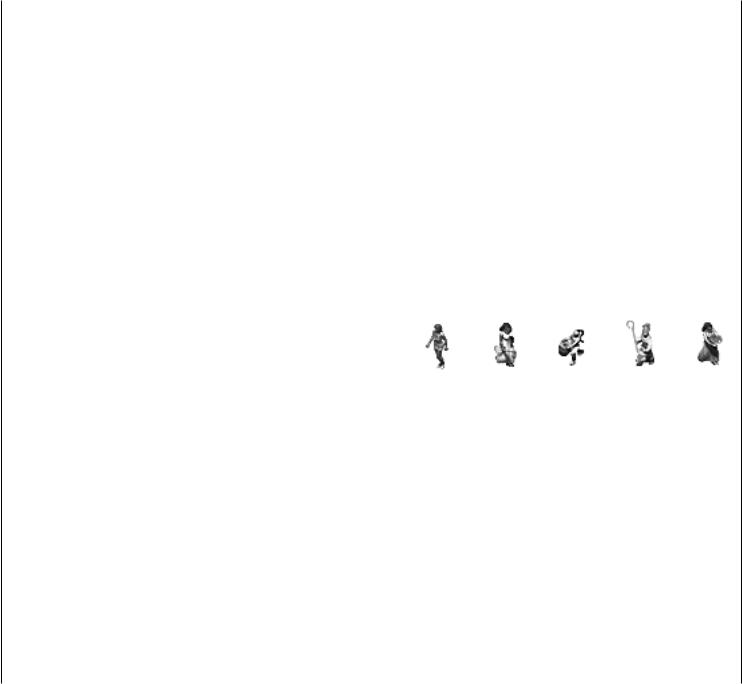
50 People and Employment
housing nearby, and if the city overall has people in need of work, then the building that sent him out will be staffed with employees. If he fails to find a staff for the building that sent him, he’ll continue his search.
People of the City
The city employs dozens of different workers who perform very different tasks. Some of the city’s workers make their way along the city’s streets as they go about their day-to-day tasks. These walkers can be broken down into two groups: those that have a specific destination in mind and those who roam the city.
Destination Walkers
Destination walkers leave their places of employment with a specific goal in mind. Using a map of your city’s roads, they determine the shortest route to their destination. With few exceptions (noted below), they always use your city’s roads to find the shortest route.
Your city’s destination walkers are:
Buyers from the Bazaar
Delivery men (cart pushers, sled pullers and chariot deliverers)
Thieves
Vagrants
Tower and wall sentries
Sledge haulers (do not need roads) Hunters (do not need roads)
Reed gatherers (do not need roads) Wood cutters (do not need roads) Soldiers (do not need roads)
Immigrants (do not need roads) Emigrants (do not need roads)
People and Employment |
51 |
These people always make a trip for a specific purpose, usually to pick up or deliver something.
Certain people who normally roam freely will sometimes have a specific destination in mind:
Performers on their way from performer’s schools to venues
Constables on their way to defend the city Fire marshals on their way to douse a fire Stonemasons, bricklayers and carpenters on their way to a monument
Unless the above walkers are performing the tasks specified, they behave as roaming walkers.
Roaming Walkers
Walkers who roam the city bring benefits to your citizens when they pass by housing. Some also provide valuable services to the buildings in the city.
Roamers leave their buildings with no specific destination in mind. When they leave their building, they try to start in a different direction every time. From there, they can be completely unpredictable.
Every time walkers who roam the city encounter an intersection, they must decide which way to turn. They don’t make the same decision every time, so houses that they have passed before may not be visited again for some time.
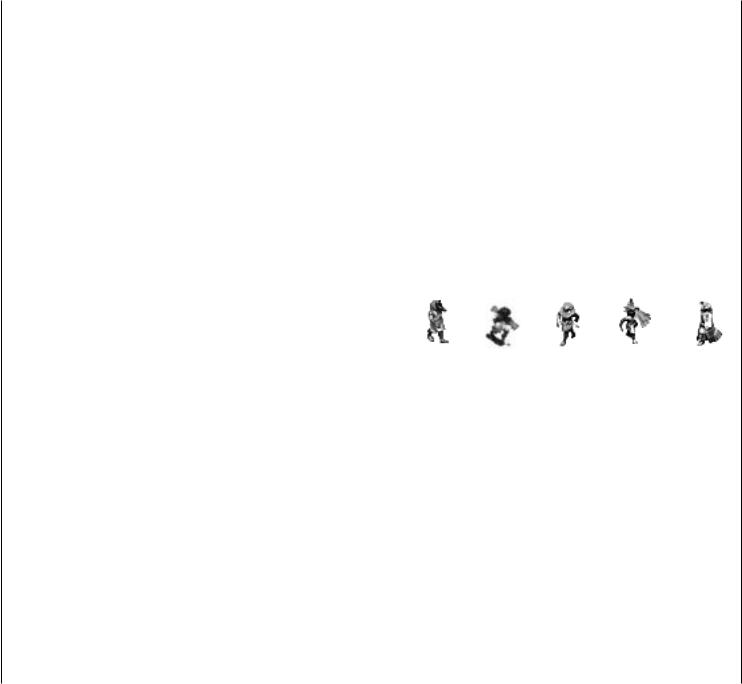
52 People and Employment
The best way to corral these walkers is through good city planning. Since intersections give these walkers so much freedom, keeping intersections to a minimum helps to guide these walkers to where you want them to go.
Roadblocks (see page 109) are another effective tool in controlling roamers. When a roamer encounters a Roadblock, he or she turns around. Walkers with a specific destination in mind pass through Roadblocks.
Use Roadblocks carefully. If you place a Roadblock to prevent a Bazaar seller from strolling through the city’s industrial sector, for example, you might also block architects and fire marshals who need to service some industrial buildings on the other side of the Roadblock. Roadblocks that separate industries from housing can also prevent buildings from finding needed employees. Roadblocks can make no distinction between roamers, so carefully consider who you might be blocking out when you use them.
The walkers who roam the city are:
Bazaar sellers
Constables (except as noted on page 51)
Magistrates
Fire marshals (except as noted on page 51)
Architects
Performers (except as noted on page 51)
Bricklayers (except as noted on page 51)
Carpenters (except as noted on page 51)
Stonemasons (except as noted on page 51)
Senet masters
Priests
People and Employment |
53 |
Teachers
Librarians
Plagued citizens
Tax collectors
Dentists
Physicians
Herbalists
Embalmers
Water carriers
If your city’s housing has evolved to very high levels (see page 41), you may also see scribes wandering around your city. Scribes enjoy the city’s services, but do not work themselves. For more on scribes, see page 57.
Unemployment
Unemployment can become a serious problem in your city, but one that is relatively easy to solve. High unemployment contributes to poor City Sentiment (see page 47) which can hamper immigration and encourage crime.
The cure to unemployment is to create new jobs. Unemployment affords you the opportunity to improve your city’s services, which could lead to a higher Culture Rating (see page 191). Check in with your Overseers (see pages 197-203) to see if your city has an adequate number of entertainment venues, Temples, Schools, Libraries and health facilities. If the city is lacking in any of these areas, solve the unem-
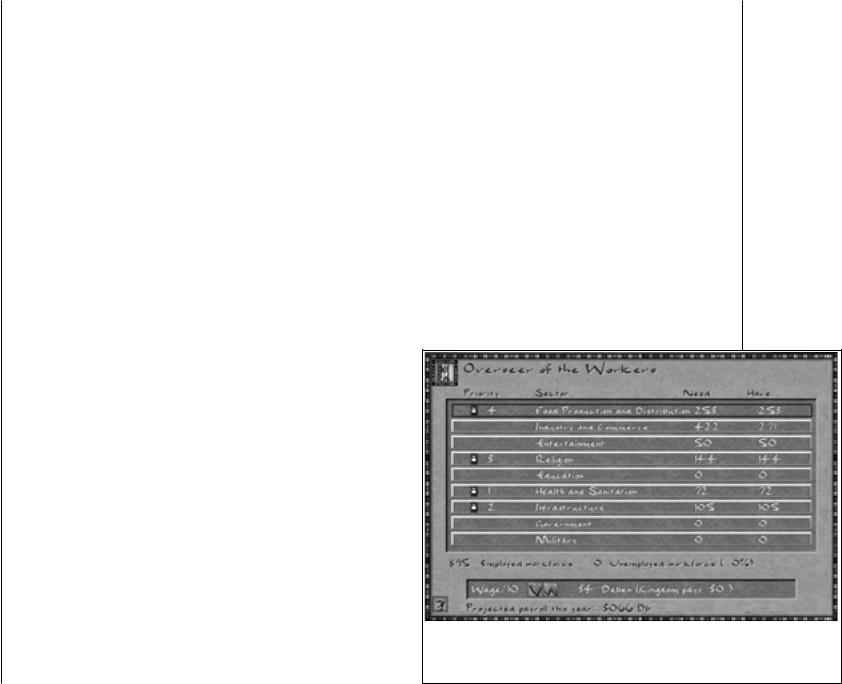
54 People and Employment
ployment problem by building more structures to provide the needed services. Use the Overlays (see pages 203-209) to see if any specific neighborhoods in the city lack particular services.
You can also turn unemployment problems into cold, hard debens. If the city is engaging in trade, check to see if it is exporting all that it can to its trade partners. If it isn’t, build more of the required industry to meet the demand. The city’s coffers will benefit.
A low level of unemployment is actually better than a labor shortage. New buildings draw their workers from the ranks of the unemployed. When more than 10 percent of citizens are out of work, though, problems will ensue.
Labor Shortages
Labor shortages can be the more devastating employment problem. When industries are understaffed, services begin to suffer because buildings that are only partially staffed are much less efficient than fully staffed buildings. When services suffer, property values go down and people are usually forced from their homes, sometimes causing emigration. Emigration, of course, further reduces the workforce which results in more services suffering.
Drawing immigrants to the city solves labor shortage problems. If the city is currently experiencing a labor shortage, manage the labor force (see below) to make sure that key services, like food production and distribution, are fully staffed.
People and Employment |
55 |
Managing Labor
Your Overseer of the Workers (page 197) and your Overseer of Commerce (page 199) can help you manage the city’s labor force to alleviate a labor shortage.
To ensure that the most important services are provided, work with your Overseer of the Workers to set employment priorities. The Overseer lists all the employment sectors in the city, the number of workers required in each sector, and the current number of workers employed in each sector. If one of the sectors that you consider to be most important is understaffed, click on it. A screen pops up with the numbers one through nine. Click the number one to make the selected sector the top priority. The Overseer of the Workers funnels employees into the work sector you’ve designated the top priority until all positions in that sector are filled. After you set a first priority, you
Overseer of the Workers’ Panel. Visit the Overseer of the Workers to set labor allocation priorities. The Overseer will fill the prioritized job sectors first.

56 People and Employment
can set a second, then a third, and so on.
You can prioritize the labor force in any order you wish. You can only have one top priority, though, and when you choose a new one, your other priorities are adjusted accordingly. Note that when you set priorities, other employment sectors can suffer from severe labor shortages.
Your Overseer of Commerce can also help solve a labor shortage by shutting down industries. Check the city’s Storage Yards and Granaries for good candidates for temporary work stoppage. If you notice that the city has a glut of a particular supply, shut that industry down for a while. That industry’s employees will find work in other employment sectors and help to reduce the labor shortage.
To temporarily shut down an industry, visit the Overseer of Commerce and click on the industry you wish to shut down. On the screen that pops up, a button reading “Industry is On” appears. Click the button until it reads “Industry is Off” to shut it down. To turn an industry back on, click the button until it reads “Industry is On.” When an industry has been shut down, it will appear in yellow on the Overseer of Commerce’s screen.
Keep an eye on the Storage Yards while industries are shut down to make sure the city doesn’t run out of any goods it needs. Also be careful when shutting down a raw material producer. If the city runs out of a raw material, manufacturers that require the item won’t be able to turn out any new goods, and their employees will sit idle unless you specifically shut down their industry, too.
People and Employment |
57 |
Scribes
When your city matures into a fine metropolis that offers the best of goods, services and, most importantly, education, some citizens become scribes. Scribes do not work, but they do pay a lot in taxes. You can watch them going about your city, pursuing leisure.
When some of your working folk become scribes, the demand for goods may increase, but your pool of available workers decreases. If immigrants don’t pour into your city to take the newly vacant positions, take steps to lure more immigrants.
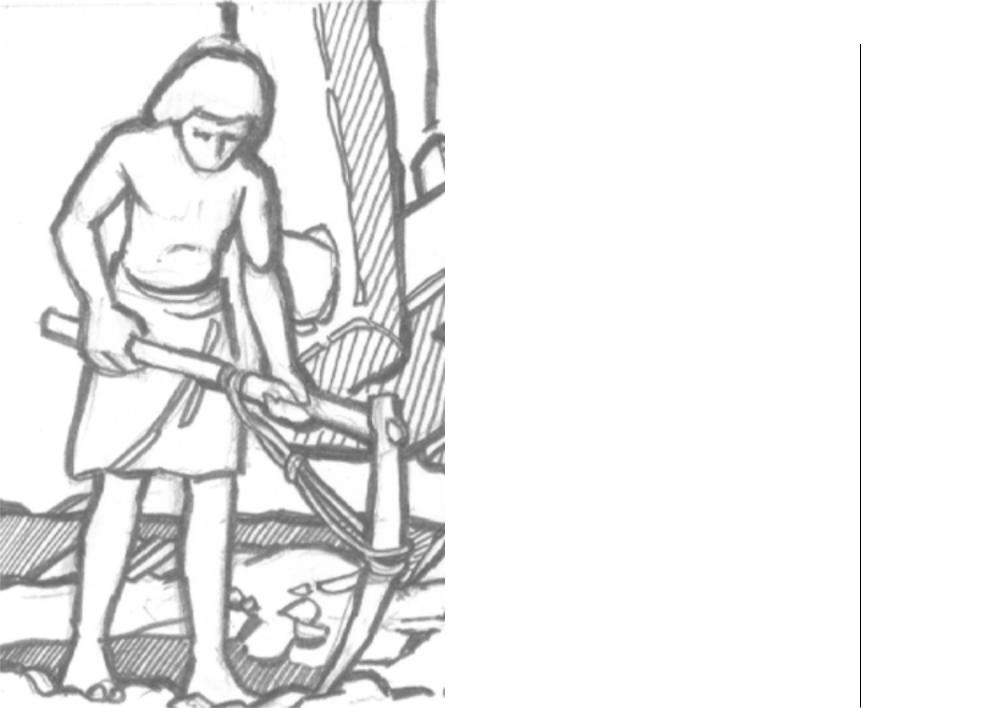
Farming and Food Production
Zoning land for houses gets people to the city. Food keeps them there. Food production is probably the single most important industry in the city, and farms will likely be the primary source of
food. The city won’t survive long without a steady supply of food. Hungry people tend to be cranky, prone to disease and eager emigrants.
Most of Egypt is dry and unarable. The fertile banks of the Nile, however, cut through like a rich, luxurious ribbon. This fertile land is limited, so you must plan farms carefully. Other areas have meadows on which farms can thrive.
The Nile, the Inundation and the Nilometer
Certainly, many great cities and countries have been built along the banks of a river. What makes the Nile so special? Each year, the Nile floods its banks, depositing nutrient-rich silt on the land. Called the Inundation, this yearly event is so important that Egyptians base their seasons on the river’s cycles.
Usually, the Nile floods its banks every year between June and September. Two to four months after the flood, the Nile recedes, leaving behind it the most fertile land in Egypt.
But, the Nile is unpredictable. It can flood high one year and low the next, or, if your city is truly unfortunate, the flood might not happen at all. Luckily, you have a Nilometer to help you gauge the coming flood’s characteristics. Priests interpret the Nilometer readings and notify your Chief Overseer (page 203)
